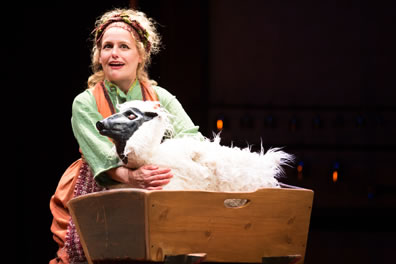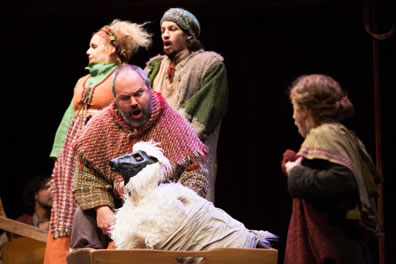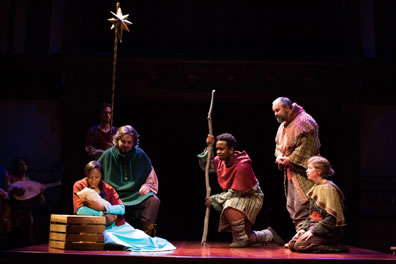The Second Shepherds' Play
The Spirit of Christmas Past
Adapted by Mary Hall Surface
Folger Theatre, Washington, D.C..
Sunday, December 4, 2016, C–13 (left stalls)
Directed by Mary Hall Surface, Music Director Robert Eisenstein

Gill (Tonya Beckman) makes much over what she claims to be her just-born baby boy—a ruse to protect her husband, who stole the sheep—in The Second Shepherds' Play, a medieval mystery play being staged by the Folger Consort at the Folger Theatre. Photo by Brittany Diliberto, Folger Shakespeare Library.
Where else, other than a children's Christmas pageant, do you get off-kilter musical performances inspiring great applause, shepherds behaving badly, and a nativity scene with bowing sheep? A medieval mystery play, of course: specifically The Second Shepherds' Play, which the Folger Consort, the Folger Shakespeare Library's early music ensemble-in-residence, is staging with some of the Washington, D.C., theater scene's best actors.
Modern English theater didn't begin with William Shakespeare, Christopher Marlowe, or Thomas Kyd, as I've long thought. While the Dark Ages between the Roman Empire and the Renaissance may have referred to a period of cultural stupor, it didn't necessarily mean the theater was dark. And though that theater was tied to the church, it wasn't as uptight as a Latin chant or as boring as a sermon. Because they were aimed at the peasant classes, mystery plays had to grab their interests with singular but familiar characters, interesting plot twists, and comic dialogue.
As this was my first experience with a medieval mystery play, this is the delightful intellectual discovery of attending The Second Shepherds' Play. Delightful also describes the production's effect on the heart as the blend of the Christmas story with a tale of grifter shepherds interlaced with ancient seasonal carols is spiritually uplifting while being a real tickler of a show.
The play's origins are a mystery beyond being among the mystery plays, biblical dramas performed in the local languages across Europe as opposed to the church's Latin. The Second Shepherds' Play appears as one of 32 medieval dramas in the 16th century Towneley manuscript, apparently generated from the efforts of the Towneleys, a Catholic family in Lancashire, to collect the scripts of popular religious theater, which was increasingly being suppressed by Protestant authorities. The Towneley manuscript, now at the Huntington Library in San Marino, California, contains two tales of the shepherds' role in the nativity story. The Second Shepherds' Play is the second of these shepherds' plays in the manuscript, hence the script's title. The Folger Consort staged the play in 2007 as its annual holiday season program with Mary Hall Surface adapting and directing it. She helms this revival, in which she's further tweaked the script.
The text is Middle English in origin, and some of that vernacular remains, sounding like a cross of Celtic with German—I drew on faint memories of my German classes way back in high school and college to glean meaning from some words. However, there's enough recognizable English—no doubt enhanced by Surface's adaptation—to help us follow not just the plot but also the gist of various conversations and soliloquies. The verse structure is rhyming couplets, and enough words are discernable to land the jokes in some of these rhymes, and the actors do their part with physical gestures and facial expressions to get across the meanings of their more obtuse lines.
In The Second Shepherds' Play, the shepherds are tending their flocks by night—on the Yorkshire Moors—when, behold, the scoundrel Mak (Ryan Sellers) arrives with the purpose of stealing himself some meat. When they all fall asleep, Mak, who had been pretending to be snoozing, makes off with a ewe and takes it home to his wife, Gill (Tonya Beckman). She frets that her husband might be hanged if his thievery is found out, so they place the sheep in her cradle and pretend it's her newborn lad. When the other shepherds show up looking for their sheep, they are originally fooled into believing that the cradle does, indeed, have a new baby, even as Mak remarks that his next meal is in the cradle, and Gill vows that if the stolen sheep is in their home, she will eat the child in the cradle.
Upon a suitable resolution to this kerfuffle, the shepherds go back to the Moors with their recovered sheep, and this time when they go to sleep they are awakened by an angel (Emily Noël), who tells them of the Son of God just born in a manger in Bethlehem. So, off to Bethlehem go the three Yorkshire shepherds, where they pay homage to the Christ Child and offer him gifts of cherries, a little bird, and a ball that looks like an early-edition baseball.
If that sounds ridiculous, put yourself among the play's original audience. They are watching their own selves, so of course the shepherds of the biblical story would be medieval herders of the Moors (Adalia Tonneyck's costumes are detailed in their medieval look). Anachronisms abound, aside from Bethlehem being two valleys over from where the shepherds were sleeping. These shepherds are clearly Christian, based on their oaths and bedtime prayer, even though they have yet to meet that religion's namesake.
Interestingly, the plot has a pagan element in it, as well, especially in the portrayals of Mak and Gill. Mak leads the other shepherds in the bedtime prayer, but then he uses an herbal spell to cast the others into a deep slumber. When the shepherds see the sheep in the cradle, the couple tries to convince them that it is, indeed, their child because Mak was witched by an elf. This con would have succeeded on the gullible shepherds if the sheep weren't tagged, identifying it as a real sheep belonging to their flock.
The anachronisms and even the pagan references are part of the larger purpose for this play. Ultimately, it's a sermon to impress on local peasants the meaning of grace under the tenets of Christianity. The shepherds on successive nights visit two cradles. The comedy of the first visitation lures the audience in for the more significant meaning of the second visitation, yet both visits carry religious resonance. At the first, the shepherds show grace to Mak and Gill; after threatening to hang him and burn her, they forego a hateful path and resolve to merely toss Mak in a canvass as if on a trampoline. At the second cradle, the shepherds receive the grace of Christ.
The play also subversively establishes a sense of suitable social order. As each of the characters make their first appearances one by one, they are full of complaint. Coll (Louis E. Davis) rails about the nobility lording over the common folk. Gib (Matthew R. Wilson) whines about being married, pointing out that men who are wedded cannot speak except in asides, and advising all young wooers in the audience, "'Had I known' is a thing that serves you not." Their boy servant, Daw (Megan Graves), gripes about masters abusing their servants, and Mak blames God for his ongoing hunger and his umpteen children Gill keeps producing. All complain about the cold. Gill gets a soliloquy harping on her husband's ignorance of all the work she does. The counter perspectives husbands and wives have toward each other hasn't changed much in half a millennium, it seems.
In the end, this play's message is that the grace of God and your place in the universal order is what matters most. Not surprisingly (in keeping with Jesus's teaching), the lowliest among them, the young Daw, is not only ultimately the wisest (the theatrical predecessor of the clever servant), he is the first to see the Star of Bethlehem and the first to understand grace. It is Daw who convinces Coll and Gib to count their sheep, it is Daw who expresses his suspicion of Mak, and it is Daw who convinces them to give over their anger and make a plaything of Mak as punishment.
All of this would make for a sweet, Sunday morning church skit in and of itself; it is the combination of Surface's staging and the Folger Consort's playing that creates such an enriching night of theater. First and foremost, Surface gathers a talented cast—not just the main characters but also ensemble members Lilian Oben (who plays Mary) and Danny Cackley (who plays the nobleman in a mask)—with a variety of theatrical credits in and beyond the National Capital Region (you can see individuals' previous mentions in Shakespereances.com via the linksbar to the right). All use direct address with the audience. Surface supplements the actors with puppets designed by Aaron Cromie: a full-scale sheep with an endearing personality (managed and voiced by Malinda Kathleen Reese) and foot-high representations of Mak (with and without the sheep) and Coll, Gib, and Daw, running over the steep hills from Moors to house. At the point of his punishment, Sellers' Mak watches in great discomfort as his puppet self gets tossed in the canvas like New York pizza dough.


The shepherds visit two cradles in the Folger Consort's production of The Second Shepherds' Play. In the first, Gib (Matthew R. Wilson) and Daw (Megan Graves) find a stolen sheep impersonating a child as Gill (Tonya Beckman) and Mak (Ryan Sellers) think up their next con. In the second, Coll (Louis E. Davis, center) along with Gib and Daw meet the Christ Child in the arms of Mary (Lilian Oben) as Joseph (Daniel Meyers) looks on. Danny Cackley is holding the star, and Brian Kay is playing the lute. Photos by Brittany Diliberto, Folger Shakespeare Library.
Scenic Designer Tony Cisek's set is a simple platform two steps up from the Folger's main stage. The idea is that this troupe could be performing in a market square or manor hall. The actors provide all the effects. To convey the cold wintery night, Beckman whirls a wind drum on one side of the stage as ensemble members wave streams of fabric on poles. The hills are represented with an unfolding rod that Oben and Reese hold for the puppets to ramble over, and the entrance to Mak's and Gil's house is a tiny, square door Reese holds up as she kneels on the stage. The three members of the Folger Consort—Director Robert Eisenstein (violin and viol), Brian Kay (lute and harp), and Daniel Meyers (wind and brass, plus the rack of bells for the angel's appearance), all dressed in medieval garb—also take part in the play's action in various ways, though without speaking any lines: Meyers portrays Joseph, and as Eisenstein, while playing his violin, tries to get a peek at the sheep in the cradle, Gil, at first pleasantly then with growing irritation, shoos him away. This blurring of the fourth wall—thespians and musicians alike serving in turn as performers, stagehands, and audience—enhances the production's congenial charm.
Just as musicians blend with the play's action, the play blends with the music and the actors become singers and percussionists (and stagehands, too) for the Consort—this is their show, after all. The Second Shepherd's Play does not come with a score, so Eisenstein and his team unearthed ancient music to accompany the play and worked with Surface to weave it all together. In addition to instrumental soundtracks and interludes, the ensemble (including actors) performs vocal music, ranging from the earliest English Christmas carols dating from the 13th century to more accessible 16th century pieces (you'll recognize "Coventry Carol" and "Greensleeves"). These are played on reproductions of original instruments, such as the rudimentary bagpipe and trombone that Meyers plays and Kay's lap harp that, despite its size and appearance as a plank of painted wood with a few strings across it, emits heavenly tones.
The musical selections are both gorgeous and, well, weird. This is ancient music, and some of it, exemplified in the opening processional "Nova, Nova," uses an incongruous rhythm structure in the verses. In his program notes, Eisenstein quotes a musician of the period, "The mo imperfit tones a man synges in the treybell, the merrier it is." Not necessarily to those of us raised on the fluid orchestrations of 19th century Romantic-era composers and the rock 'n' roll songsters of the late 20th century (Jethro Tull and early Genesis aside). You think speaking Middle English is hard? Each cast member except Beckman and Sellers sings a verse of "Nova, Nova," and in my opinion that is the biggest challenge of their individual roles. Also incongruous, but gorgeously fascinating, are the songs with a multitude of melodies being sung simultaneously but all in accordance: think baroque instrumentals, but with voices and more layers. We get a sample of this with the carol "Nowell, Nowell," in which Noël, a sumptuous soprano, starts off the song and is joined in counter melodies by first Cackley, then Reese, and finally Meyers with his trombone.
Like "Nowell, Nowell," the various elements of the The Second Shepherds' Play combine into a sensory symphony touching heart, mind, and soul while raising your spirits.
Eric Minton
December 9, 2016
Comment: e-mail editorial@shakespeareances.com
Start a discussion in the Bardroom



 Find additional Shakespeareances
Find additional Shakespeareances